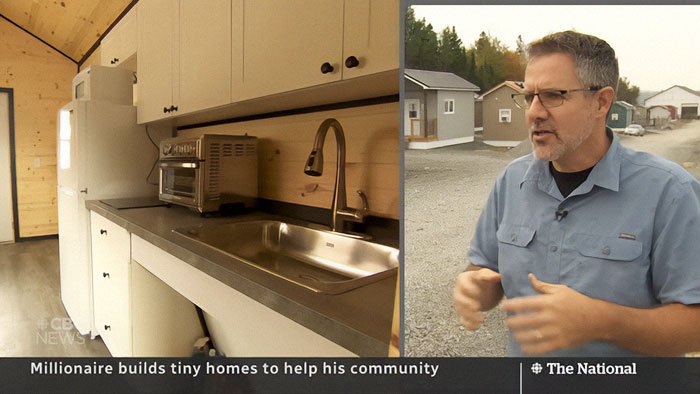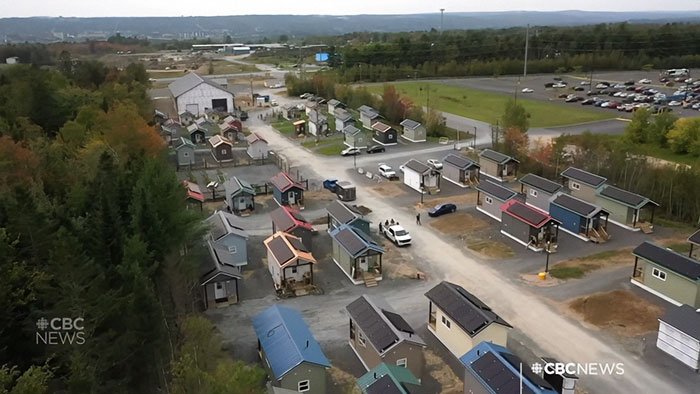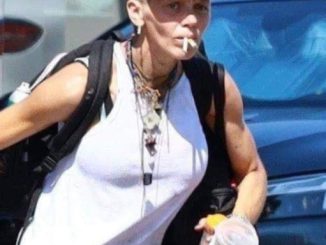Homelessness is a problem that many cities face around the world. Even though governments and organizations are trying to fix it, it’s still a big issue. One Canadian millionaire decided to make a difference in his own town with his money. Here’s his story.
In Fredericton, New Brunswick, Marcel LeBrun, a millionaire entrepreneur, took action to help homeless people in his community. Marcel, who made a lot of money from his successful social media monitoring company, decided to invest $4 million of his own money to build 99 tiny homes for those in need. He didn’t just stop at providing homes; he also created job opportunities with his unique approach. This project is called 12 Neighbours.
After selling his company and gaining a lot of wealth, Marcel wanted to use his money for good. Seeing the homelessness issue in Fredericton, he came up with the idea of a tiny home community to give homeless people a new start. He named his project 12 Neighbours and aimed to build a gated community with 99 homes and an enterprise center. This community offers both housing and job opportunities, giving homeless people a chance to rebuild their lives.

Homelessness is a big issue in New Brunswick, with about 1,600 people experiencing it in a single day last year. In bigger cities like San Francisco, Los Angeles, and New York in the United States, the number of homeless people is much higher. Marcel LeBrun saw a chance to make a difference and decided to help those struggling with homelessness.
Marcel’s project, 12 Neighbours, is not just about building tiny homes. He wants to create a supportive community for people. The tiny homes he’s building are more than just places to stay. They are fully-furnished with kitchens, living areas, bedrooms, and full bathrooms. They even have solar panels on the roofs. Marcel sees himself as a community builder, aiming to provide a better life for those in need.

To make his vision a reality, Marcel LeBrun set up a factory where skilled volunteers help build the tiny homes. Using modern techniques, the factory can produce one tiny home every four business days. Once a home is built, it is carefully placed on concrete blocks to form the foundation of the community.
Marcel believes that owning a home is important because it gives people a sense of responsibility and stability. By allowing people who have experienced homelessness to own their own homes, the 12 Neighbours project aims to empower them and create a supportive community.

Besides providing homes, Marcel LeBrun’s project also focuses on creating job opportunities for the residents. The 12 Neighbours community includes an enterprise center with a coffee bar and a silk printing business, both run by the residents. This helps generate income and encourages residents to interact with the wider community.
Like any big project, 12 Neighbours has faced criticism. Some people think it’s better to reintegrate homeless individuals directly into society rather than keeping them together in one place. However, Marcel understands these concerns and has taken steps to ensure the community is safe and supportive.
Marcel explained, “Building a few homes is just as complicated as building many, and we wanted to make a real impact on homelessness in Fredericton. If we want to make a meaningful difference, we need to build houses. If I take someone who’s been living outside and put them in a luxury apartment, they might not succeed because it’s not their community or environment.”

Marcel LeBrun knows how important safety is, so he has included top security features in the 12 Neighbours community. There are gated entrances and advanced surveillance systems to ensure residents feel safe and protected.
LeBrun mentioned that some residents face challenges when they first move in. He explained, “When someone moves into a house, they might have others trying to take advantage of them. They need to learn what it means to manage their own space and decide who they let in and out.”
One of the main goals of 12 Neighbours is to build a strong sense of community both inside and outside its gates. LeBrun wants to create a place where residents and the people of Fredericton can come together. The community has a coffee bar and a personalized printing business to encourage interaction and understanding.
LeBrun told CBC, “I see myself as a community builder. We’re not just building a small community; we’re helping to make our city better.”
Marcel LeBrun’s project to build 99 tiny homes in Fredericton, New Brunswick, is a great example of using personal success to help others. Through 12 Neighbours, he has not only provided homes for those in need but also created job opportunities and a supportive community. His efforts have given hope to many and inspired others to make a difference.
A Rare and Stunning Sight Awaits
Skywatchers, get ready! On the night of March 14-15, 2025, a total lunar eclipse will grace the skies, offering a breathtaking celestial spectacle. For approximately 65 minutes, the Moon will transition from its usual bright white glow to a dramatic deep red or brown hue, creating a mesmerizing sight known as the Blood Moon.
If you’re fascinated by astronomy or simply love witnessing nature’s wonders, this is an event you won’t want to miss. Whether you’re planning to observe it with the naked eye, through a telescope, or capture stunning photographs, this guide will provide all the essential details you need.
What Is a Total Lunar Eclipse?

A total lunar eclipse occurs when the Earth comes directly between the Sun and the Moon, casting a shadow that completely covers the Moon. Unlike a solar eclipse, which requires protective eyewear, a lunar eclipse is perfectly safe to view with the naked eye.
During this event, the Earth’s atmosphere filters sunlight, allowing only longer-wavelength red and orange light to reach the Moon. This is what gives the Moon its eerie red or brown appearance, often referred to as a Blood Moon.
When and Where Can You See It?
The total lunar eclipse will be visible from various parts of the world, but some regions will experience a better view than others. Here’s what you need to know:
- Best viewing locations: North America, South America, parts of Europe, and western Africa will get the best views of the full eclipse.
- Partial visibility: Some areas in Asia and eastern Africa will see only a partial eclipse.
- Total eclipse duration: Approximately 65 minutes of complete totality.
- Eclipse phases: The entire event, from the penumbral phase to the total eclipse and back, will last about three hours.
Video : Total Lunar Eclipse 2025: Will the Stunning Blood Moon Grace Your Skies?
If you’re in an area where visibility is limited due to weather conditions or location, don’t worry! Many astronomy organizations and space agencies will offer live-streams of the event.
What Causes the Blood Moon Effect?
One of the most fascinating aspects of a total lunar eclipse is the Blood Moon phenomenon. But why does the Moon turn red instead of disappearing completely?
This happens due to a process called Rayleigh scattering, the same mechanism responsible for red sunsets and sunrises. When the Earth blocks direct sunlight from reaching the Moon, some of the Sun’s light bends through the Earth’s atmosphere. The shorter wavelengths (blue and violet) scatter, while the longer red and orange wavelengths pass through and illuminate the Moon.
Depending on atmospheric conditions, the Moon can appear in shades ranging from deep red to copper or brown. If there are dust or volcanic particles in the atmosphere, the eclipse could take on an even darker hue.
How to Watch the Total Lunar Eclipse
Viewing a total lunar eclipse is easy and requires no special equipment. However, for the best experience, consider these tips:
- Find a dark location: The farther you are from city lights, the clearer your view will be.
- Check the weather: Cloudy skies can block your view, so make sure to check local forecasts.
- Use binoculars or a telescope: While the eclipse is visible to the naked eye, magnification enhances details like craters and surface textures.
- Capture the moment: If you love photography, use a DSLR camera with a tripod to get sharp images of the Moon’s color changes.
- Bring friends and family: Viewing an eclipse is a magical experience—share it with others!

Why This Lunar Eclipse Is Special
Not all lunar eclipses are created equal. Some are penumbral (where the Moon only passes through Earth’s outer shadow), while others are partial (where only part of the Moon is covered).
However, this event on March 14-15, 2025, is a total lunar eclipse, meaning the Moon will be completely engulfed by Earth’s shadow, creating an intense and dramatic visual effect.
Additionally, this eclipse comes at a time when interest in space and astronomy is at an all-time high, with upcoming missions to the Moon and Mars capturing global attention.
The Cultural and Historical Significance of Lunar Eclipses
Throughout history, lunar eclipses have been seen as mystical and sometimes ominous events. In ancient civilizations:
- The Incas believed a lunar eclipse occurred when a jaguar attacked the Moon.
- The Chinese thought a giant celestial dragon was devouring the Moon and would make loud noises to scare it away.
- Many Native American tribes viewed the event as a sign of change or transformation.
Today, lunar eclipses are understood scientifically, but they still inspire a sense of wonder and curiosity.
Video : Total Lunar Eclipse Blood Moon 14 March 2025 Your Horoscope with Gregory Scott
The Next Total Lunar Eclipses After March 2025
If you miss this one, don’t worry—there are more lunar eclipses coming in the future. The next total lunar eclipses will occur on:
- March 3, 2026
- December 31, 2028
- December 20, 2029
However, the March 2025 eclipse will be one of the longest and most visible in recent years, making it a must-watch event.
Final Thoughts: Don’t Miss This Celestial Event!
The March 14-15, 2025, total lunar eclipse is a rare and breathtaking natural event that reminds us of the beauty of our universe. Whether you’re an astronomy enthusiast or just someone who enjoys witnessing celestial wonders, this is an opportunity you won’t want to miss.
Mark your calendars, find a good viewing spot, and prepare to watch the Moon turn a stunning shade of red as it aligns perfectly with the Earth and Sun.
Are you excited for the eclipse? Share your thoughts in the comments and let us know where you’ll be watching from! Also, don’t forget to share this article with fellow space lovers so they can witness this incredible event, too.



Leave a Reply